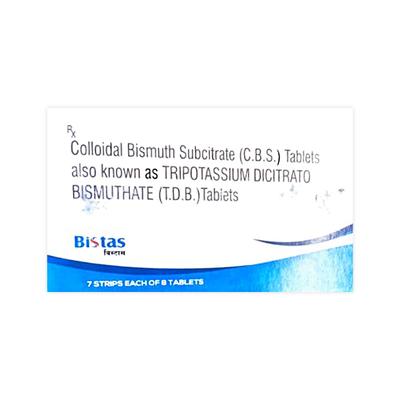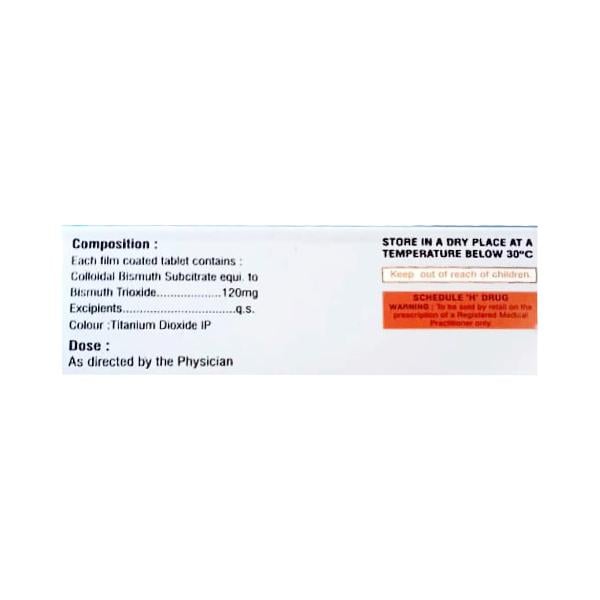

Netmeds First Membership
Quick Links
Introduction About BISTAS TABLET
BISTAS TABLET contains Colloidal bismuth subcitrate which belongs to the group of medicines called Anti-ulcer agents. BISTAS TABLET is used to manage duodenal and gastric ulceration in affected individuals.
BISTAS TABLET is also used to manage non-ulcer dyspepsia (indigestion) that occurs due to H.pylori associated gastritis (inflammation of stomach), when used in combination with antibiotic therapy. The medicine is also indicated for use in 14 day programme to eradicate H.pylori infection (bacterial infection) with/without association with non-ulcer dyspepsia in affected individuals.
BISTAS TABLET is not recommended for use in patients allergic to Colloidal bismuth subcitrate. It is also not recommended for use in patients suffering from severe renal impairment.
Before taking BISTAS TABLET, inform your doctor if you suffer from liver problems.
BISTAS TABLET is generally not recommended for use during pregnancy and in breastfeeding women unless it is clearly necessary.
BISTAS TABLET should be used with caution in children (aged below 3-years) and is advised to be used with caution in elderly patients (aged 65years/above) after consulting the doctor.
The most common side effects associated with use of BISTAS TABLET are abdominal pain, headache, nausea, vomiting, diarrhoea, black stools, and/or dizziness. Consult your doctor if any of these symptoms worsens.
Uses Of BISTAS TABLET
- Manage duodenal and gastric ulcer
- Manage non-ulcer dyspepsia (indigestion) that occurs due to H.pylori associated gastritis (inflammation of stomach), when used in combination with antibiotic therapy
- Helps to eradicate H.pylori infection (bacterial infection) with/without association with non-ulcer dyspepsia in 14 day programme in affected individuals
How BISTAS TABLET Works
BISTAS TABLET works by binding strongly to the proteins in ulcerated tissue of stomach which leads to formation of protective layer in stomach resulting in protection from aggressive factors and promoting its healing from duodenal and stomach ulcers in affected individuals. It also causes destruction of H. pylori bacteria (organism responsible for gastritis and ulcer relapse) in affected individuals which results in healing of stomach from gastritis and management of occurrence of ulcer relapse associated with H.pylori bacteria.
How to use BISTAS TABLET
Take BISTAS TABLET as advised by your physician. Swallow the medicines with a glass of water. Do not crush or chew the medicine. Your physician will decide the correct dose and duration for you depending upon your age, body weight and disease condition.
Side Effects Of BISTAS TABLET
Common
- abdominal pain, nausea, vomiting, diarrhoea
- black stools
- dizziness
- headache
- metallic taste
How To Manage Side Effects
Nausea and vomiting:
Take BISTAS TABLET with/just after a meal. Stick to simple meals. Avoid eating oil rich/spicy foods, sugary snacks, and/or drinks. Avoid drinking too much liquid along with your meals, and drink slowly in between meals. Consult your doctor if the condition worsens.
Diarrhoea:
Drink plenty of water and stay hydrated. Try to avoid taking any medicine on your own to manage diarrhea. Consult and inform your doctor if the symptom worsens.
Dizziness:
Try to rest and get enough sleep. Try to avoid driving or operating any tools or machines while you feel dizzy. Limit consumption of alcohol, as it can aggravate dizziness. Consult and inform your doctor if the symptom worsens.
Headache:
If BISTAS TABLET causes headache, then take rest and drink plenty of fluids. Try to avoid drinking alcohol. Ask your doctor to recommend a painkiller. Headaches should usually go away after the first week of taking BISTAS TABLET. If it lasts more than a week or becomes severe, then consult and inform your doctor.
Warning & Precautions
Pregnancy
BISTAS TABLET is generally not recommended for use during pregnancy unless it is clearly necessary. Consult your doctor before taking the medicine.
Breastfeeding
BISTAS TABLET is generally not recommended for use in breastfeeding women unless it is clearly necessary. Consult your doctor before taking the medicine.
Driving and Using Machines
BISTAS TABLET is unlikely to affect your ability to drive or operate any machines. Consult your doctor before taking the medicine.
Kidney
BISTAS TABLET is not recommended for use in patients with severe renal impairment. Consult your doctor before taking BISTAS TABLET.
Liver
BISTAS TABLET should be used with caution in patients with liver problems. Consult your doctor before taking BISTAS TABLET.
Allergy
Do not take BISTAS TABLET if you are allergic to Colloidal bismuth subcitrate, and/or any other ingredients of this medicine.
Others
Use in Paediatrics:
BISTAS TABLET should be used with caution in children (aged below 3-years). Consult your doctor before administering the medicine to the child.
Use in Geriatrics:
BISTAS TABLET should be used with caution in elderly patients (aged 65years/above). Consult your doctor before taking the medicine.
Interactions
A. Drug–Drug interactions:
Before taking BISTAS TABLET, inform your doctor if you are taking following medicine:
- tetracycline (medicine used to manage bacterial infections) Ex. lymecycline, methacycline
- antacids (used to relieve indigestion and heartburn) Ex. aluminum hydroxide, magnesium carbonate
B.Drug-food interactions:
Avoid consumption of milk, fruit/fruit juices while taking BISTAS TABLET since it may alter the effect of the medicine.
Overdosage:
If you or anyone else accidentally take too much of BISTAS TABLET, consult your doctor immediately or visit the nearby hospital. Overdosage symptom is reversible renal failure (associated with signs such as decreased urine output, swelling of arms/legs, shortness of breath, fatigue, and/or confusion).
Synopsis
| Drug | : | Colloidal bismuth subcitrate |
| Pharmacological Category | : | Anti-ulcer agent |
| Therapeutic Indication | : | Duodenal & gastric ulcer, non-ulcer dyspepsia, H.pylori infection |
| Dosage Forms | : | Tablet |
More Information
- Keep BISTAS TABLET out of reach of children
- Do not store BISTAS TABLET above 30°C
FAQs About BISTAS TABLET
What is BISTAS TABLET used for?
BISTAS TABLET is used to manage duodenal and gastric ulcer which is also used to manage non-ulcer dyspepsia (indigestion) that occurs due to H.pylori associated gastritis (inflammation of stomach), when used in combination with antibiotic therapy in affected individuals. It is also indicated for use in 14 day programme to eradicate H.pylori infection (bacterial infection) with/without association with non-ulcer dyspepsia in affected individuals.
What are the common side effects of taking BISTAS TABLET?
The most common side effects associated with use of BISTAS TABLET are abdominal pain, headache, nausea, vomiting, diarrhoea, black stools, and/or dizziness. Consult your doctor if any of these symptoms worsens.
How BISTAS TABLET works?
BISTAS TABLET works by binding strongly to the proteins in ulcerated tissue of stomach which leads to formation of protective layer resulting in protection from aggressive factors and promoting its healing from duodenal and stomach ulcers in affected individuals. It also causes destruction of H. pylori bacteria (organism responsible for gastritis and ulcer relapse) in affected individuals which results in healing of stomach from gastritis and management of occurrence of ulcer relapse associated with H.pylori bacterial infection.
How BISTAS TABLET should be taken?
Take BISTAS TABLET as advised by your physician. Swallow the medicines with a glass of water. Do not crush or chew the medicine. Your physician will decide the correct dose and duration for you depending upon your age, body weight and disease condition.
Can BISTAS TABLET be used in pregnant and breastfeeding women?
No, BISTAS TABLET is generally not recommended for use in pregnant and breastfeeding women unless it is clearly necessary. Consult your doctor before taking the medicine.
References
1. KD. Tripathi. Drugs for Peptic Ulcer and Gastroesophageal Reflux Disease. Essentials of medical pharmacology. Seventh edition. 2013. Page – 656.
2. Alexander C Ford, Peter Malfertheiner, Monique Giguère, José Santana, Mostafizur Khan, Paul Moayyedi. Adverse events with bismuth salts for Helicobacter pylori eradication: Systematic review and meta-analysis. NIH National Library of Medicine. National Center for Biotechnology Information. PMC PubMed Central. December 2008. [Accessed on 10th August 2022] https://www.ncbi.nlm.nih.gov/pmc/articles/PMC2778120/
3. Maria Pina Dore, Emmanouil Maragkoudakis, Antonella Pironti, Vincenza Tadeu, Rinaldo Tedde, Giuseppe Realdi, Giuseppe Delitala. Twice-a-day quadruple therapy for eradication of Helicobacter pylori in the elderly. NIH National Library of Medicine. National Center for Biotechnology Information. PubMed.gov. February 2006. [Accessed on 10th August 2022] https://pubmed.ncbi.nlm.nih.gov/16423090/
4. Arya Pharmaceutical Company. Bismuth Subcitrate Arya. [Revised in January 2018] [Accessed on 10th August 2022] http://aryapharm.com/wp-content/uploads/2018/05/Bismuth_Arya.pdf
5. Tri-Med Distributors Pty Ltd. Colloidal Bismuth Subcitrate. [Accessed on 10th August 2022] https://static1.squarespace.com/static/5eb0b46ec3594a3559c2c9b5/t/6152c36e593dd86e70223b2d/1632813937070/FINAL+Colloidal+Bismuth+Sub+PI_2021_v2.pdf
Useful Diagnostic Tests
- Gastroscopy










